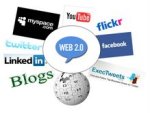Reputations at Risk in Web 2.0’s ‘Global Village’
Explosion of User-Generated Media in the Age of Social Networks Creates Important New Reputation Management Challenges

Today, two thirds of what Nielsen Online calls “the world’s Internet population” visit social networks or blogs, which have become the fourth most popular online sector after search, portals and PC software applications (Nielsen, Global Faces and Networked Places, March 2009). Enabled by Web 2.0 technology*, this thriving new type of user-generated media, often designated as social media, is proliferating on public and private virtual spaces at an incredible rate. Blogs, wikis, podcasts, message boards, virtual communities and networking tools flourish every day, challenging traditional outlooks on how issues are framed, messages are circulated and reputations – brand, corporate and personal – are managed.
Thanks to Web 2.0, tweets, posts, and other forms of digital communications are redefining the way people and organizations communicate, opening the door to a new world of free and easily accessible information sharing, unedited and uncensored contents, and global – borderless – interactions. This is exemplified by the ability of citizens in Iran breaking through government censorship to communicate with the outside world on civil unrest in the country through Facebook and Twitter posts.
Worldwide reach in seconds
For organizations and individuals who value their reputations, this development creates new and increasingly serious challenges. In fact, in the Web 2.0 global village – where anyone can initiate a worldwide controversy almost instantaneously, frame an issue positively or negatively, or feed international debate with a simple blog post – every reputation is at risk.
For example, social media tools such as blogs and social networks enable anyone frustrated with a company’s practices, products or services to spread their complaints virally and potentially stimulate a local, national or global campaign against the company. For consumer activists and special interest groups, these tools have become powerful instruments to stage attacks on companies and rally support for their positions.
Companies like Amazon, recently faced the anger of thousands of bloggers for its re-classification of gay and lesbian themed books as “adult” books. Even Apple, a favorite of the wired crowd, came under fire from Greenpeace bloggers for its alleged lack of involvement regarding environmental issues. Starbucks, the “socially progressive” coffee giant, is currently dealing with a media campaign rooted in social media which alleges the company as anti-organized labor.
 |
In today’s digital world, disgruntled workers, distraught ex-workers, whistleblowers and digital spies are now one click away from spreading confidential information, classified reports and/or stories on questionable practices they might have encountered. On websites such as http://www.wikiLeaks.com, http://www.thesmokinggun.com, or http://www.sharesleuth.com, they are now able to gather and archive leaked information, which then becomes searchable and printable by anyone at anytime.
The risks to reputations are real, and because there is no such thing as a digital eraser to remove individual attacks and negative publicity, every polemic growing in the Web 2.0 global village can potentially become an exponential threat to corporate – and individual – interests worldwide.
Using Web 2.0 to your advantage
However, as much as social media creates risks, Web 2.0 can also be a valuable tool for those who want to understand and potentially manage the actions, trends, and opinions that shape their reputations. As a borderless window to millions of minds around the world, Web 2.0 offers the opportunity to better understand global trends and opinions in the making – a knowledge which is critical to anticipating issues and/or crises and developing effective response strategies.
That is why organizations and individuals who consider their reputation a valuable asset should invest the time and resources needed to understand today’s global digital village and actively engage with its burgeoning pool of bloggers, twitters and social networkers.
 |
Protecting reputations and maximizing opportunities in the world of Web 2.0 involves three basic steps:
1. Monitor
2. Analyze
3. Engage
Blogs and social networks can be global focus groups, borderless suggestion boxes which gather the first formulations of business, cultural, political and social trends and evolving developments. To leverage the benefits of social media, one must, first and foremost, put in place a system to MONITOR online word-of-mouth interactions, using various tools to listen and dig through myriad tweets, posts and blogs to find insights into public opinions and actions.
Organizations must then ANALYZE their findings; evaluate the meaning of aggregated individual thoughts and reactions; assess the evolution of online networks and communities; and locate and map trends and their initiators.
Ultimately, organizations must actively ENGAGE with the millions of digital minds which aspire to discuss, debate and influence the decisions being made about the products they purchase, the services they use, the environments in which they live and the issues they care about.
 |
Whether it is by blogging, tweeting, linking, or creating their own forums, organizations must be proactive online if they want to maintain control over their reputations. They must engage with online communities, be aware of participant concerns and, when appropriate, develop responses to those concerns. In the Web 2.0 global village – where people live and learn through uncensored dialogue and near instantaneous interactions – traditional external communications utilizing earned and paid media are no longer enough.
Managing issues and enhancing the reputations of our clients has been the highest priority of my firm, Winner & Associates, since its founding in 1975. Our global Advanced Reputation Management System gives our clients a competitive advantage in the constantly evolving world of Web 2.0. For more information, please contact Zach Winner at zwinner@winnr.com.
* Web 2.0 refers to a second generation of web technologies and applications that facilitate communications, information sharing, and collaboration online in ways previously unavailable. Examples of Web 2.0 applications include social-networking sites, video-sharing sites, wikis and blogs.